Women's Work
What do these photos tell you about the kind of work farm women did?
Feeding Farm Animals
This photo shows two women feeding farm animals. It was taken on a farm or ranch in Colorado.
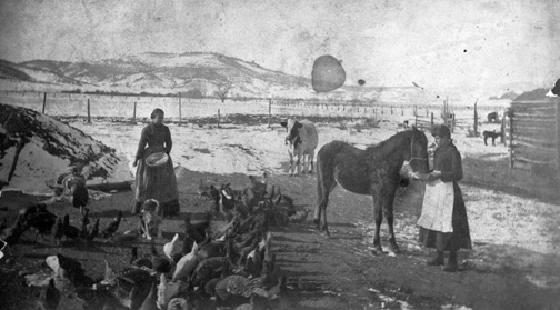
Photo: Denver Public Library, Western History Collection
More About This Topic
Women's chores on a farm or ranch included helping to feed the barnyard animals. Feeding the chickens and gathering the eggs was usually a woman's job. Farm women also had to cook for their families and for neighbors who came to help during busy seasons such as threshing time.
Their Own Words
"The women of the house had their share of the work. All the neighbors who helped with the harvest ate with the family in the house. In the very early days it took several days to thresh all a man's grain. Usually there were up to twenty persons for the noon meal."
Source: Hazel Webb Dalziel, "The Way It Was," The Colorado Magazine, 45 (Spring 1968): 110.
Cooking In a "Horno"
This photo was taken in Southern Colorado near Trinidad. The woman is standing beside a horno or outside oven. Spanish-American settlers built ovens made of clay outside the house. This kept the house from getting too hot on baking days.
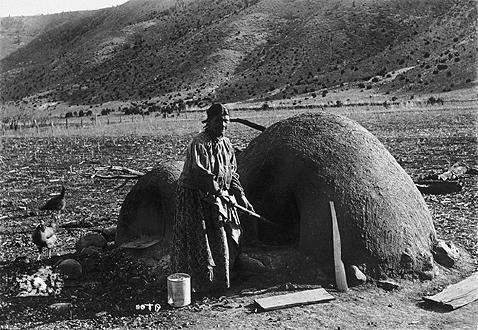
Photo: Colorado Historical Society
More About This Topic
Women on Colorado farms grew and prepared most of the food their family needed. They baked bread, cooked meals, and raised and preserved garden vegetables.
Their Own Words
“The agriculture of the Mexicans of that day was as crude as could be imagined. There was no such thing as a grain harvester or a threshing machine. The grain was cut by hand, and after binding and stacking was spread around the stack for the sheep to tramp out . . . . The baking of the bread after the grain was ground into flour . . . was done in an egg-shaped adobe oven [a horno] set out in the yard and fired with a few handfuls of weeds or grass.”
Source: James K. Hastings, “Boyhood in the Trinidad Region,” Colorado Magazine, 30 (April 1953): 106-07.
Making The Family's Clothes
The women in this photo are sewing. The one in the center is using a sewing machine. The other woman is sewing by hand.
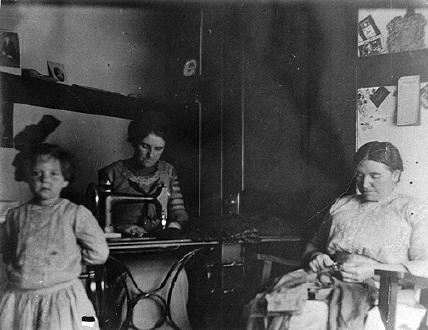
Photo: Colorado Historical Society
More About This Topic
During the 1800s, women also made most of their family's clothes. Sewing machines made that work easier. Families who settled in Colorado after the 1870s usually had sewing machines like the one in this photo. Still, much of the sewing was done by hand.
Their Own Words
“Well, my husband would go to town and he’d buy me some material. Two kinds—I have a bunch of girls [actually, 16 children in all]. So he’d bring maybe 20, 25 yards of one and 25 of the other, and I’d sew the girls two dresses [each]. With what they had and what I sewed, they had enough to go to school in. We’d wash them, and they wore them to school. But when they come home from school, they took them off, kept them nice, you know. He’d go to town in the spring [and] get me some kind of nice material to make the girls’ Easter dresses—maybe be yellow, pink, or white.”
Source: Julia Biskup Kawcak quoted in Julie Jones-Eddy, ed. Homesteading Women: An Oral History of Colorado, 1890-1950 (New York: Twayne, 1992): 47.
Bathing Baby (late 1800's)
The woman in this photo is bathing her baby in a tub in the kitchen. The tub and soap were placed on a board on a kitchen chair.
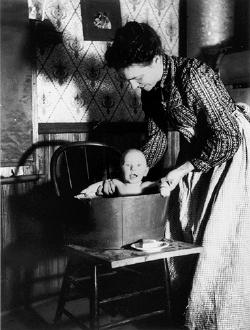
Photo: Colorado Historical Society
More About This Topic
A Colorado farm woman also spent a great deal of time caring for her children. That included giving young children baths in tubs like the one in this photo. Few farm houses in the 1800s had bathrooms with hot water. Baths were usually given in the kitchen where water was heated on the kitchen stove.
Their Own Words
"Imagine if you can the simple matter of bathing. This was a Saturday night activity and started off immediately after the supper was cleared away. A wash boiler of water was put on the fire to heat, rugs and papers were spread on the newly scrubbed floor, and a galvanized tub was brought in and partially filled with warm water. The oven door was let down and a towel spread on it to warm. As I was next to the youngest I was second for the bath. My long braids were pinned on top of my head (One's hair was washed in daytime so it would dry before night. to go to bed with damp hair was sure to bring on a cold or some other illness. I was a long time getting over this belief.) My clothes were removed and I climbed in the tub."
Source: From Hazel Webb Dalziel, "The Way It Was," The Colorado Magazine, 45 (Spring 1968): 102.
Milking The Cows
The farm (or ranch) woman in this photo is milking a cow. This chore was usually not just women's work, but farm and ranch women pitched in to do almost any chore around the farm or ranch.
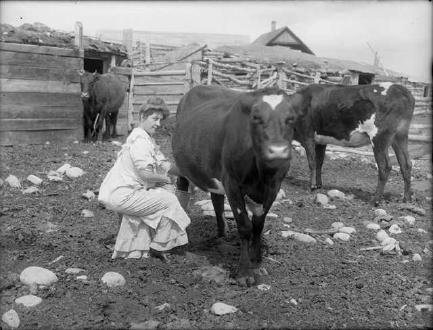
Photo: Denver Public Library, Western History Collection
More About This Topic
You can also see other cows and a barn made of logs in the background of the photo. Notice that the roofs of the barn and other buildings was made of sod or dirt. This photo was taken about 1890.
Their Own Words
”But we had to take responsibility—we learned to milk cows at a very early age and [to] do all the things that had to be done, because my dad had to be gone some and work out to make a living. We weren’t that well fixed financially, and we had to help Mother take ahold and do the garden work and take care of the animals and shovel out the ditches and all that sort of thing. It just had to be done, and we all learned to work.”
Source: Ila Bowman Powell quoted in Julie Jones-Eddy, ed. Homesteading Women: An Oral History of Colorado, 1890-1950 (New York: Twayne, 1992): 79.
Churning Butter (1890)
After milking the cows was done, other chores remained to do. The farm (or ranch) woman in this photo is sitting outside her home. But she is not idle. She is churning butter in the wooden butter churn to her right.
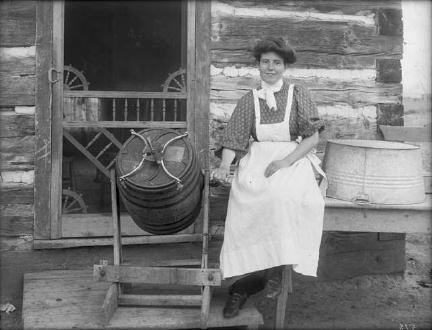
Photo: Denver Public Library, Western History Collection
More About This Topic
Notice that she is wearing an apron over her dress. Notice, too, that a washtub is sitting on the table to her left. Her home was made of rough-cut logs. This photo was taken about 1890.
Their Own Words
“[My Dad] milked cows and delivered milk in a horse and wagon. All us children did [deliver milk]. My mother had eleven children. We delivered about three hundred quarts [of milk] in the morning and about that much at night. . . . At night you didn’t get through until seven-thirty or eight o’clock at night. . . . We milked cows by hand . . . I’d milk about twelve, maybe fifteen. My mother separated the surplus milks and made butter and buttermilk. Usually on Saturday we’d deliver our milk. Then we’d come back, and she’d have all the butter ready, and we’d go back out and deliver butter. I was nine years old and my sister was two years younger. It seemed like everybody worked.”
Source: Klubert Watembourg quoted in Maria M. Rogers, ed., In Other Words: Oral Histories of the Colorado Frontier (Golden, CO: Fulcrum Publishing, 1996): 23.

